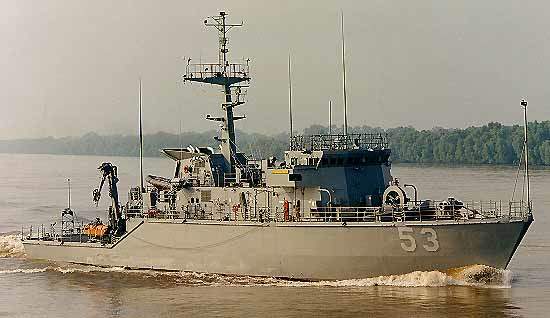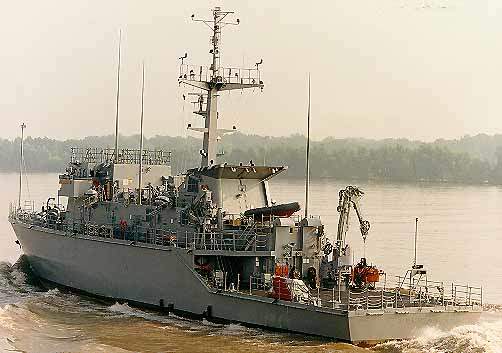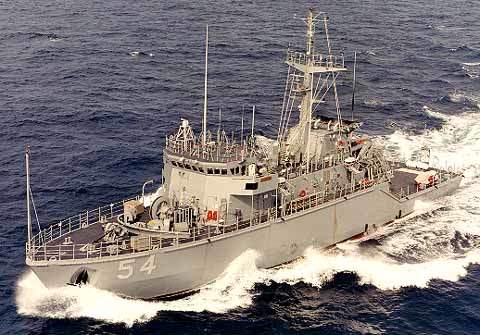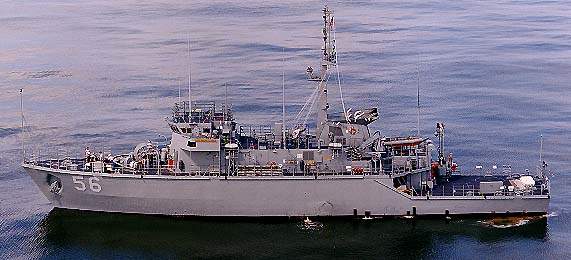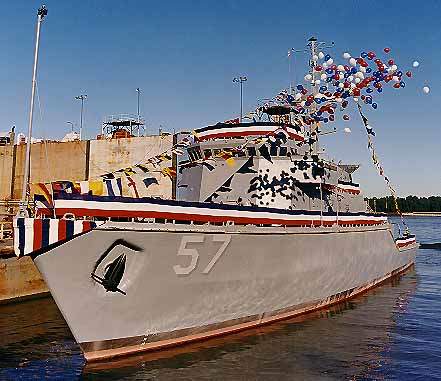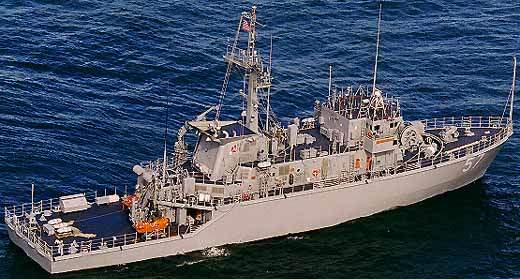The Osprey Class ships are the world’s largest Glass-Reinforced Plastic (GRP) ships and are the first US Navy ships designed solely for minehunting. The technique used to locate mines is by high-definition sonar and the mines are neutralised with a remotely controlled underwater vehicle. The platform has been designed with exceptionally low magnetic and acoustic signatures to protect against mine detonations during minehunting operations.
12 minehunter ships were built for the US Navy by Northrop Grumman Ship Systems (formerly Litton Avondale Industries) of New Orleans and Intermarine of Savannah. The ships were commissioned between 1993 and 1999.
The 12 ships were decommissioned from the US Navy between 2006 and 2007:
USS Osprey (MHC 51), USS Robin (MHC 54), USS Falcon (MHC 59) and USS Oriole (MHC 55) in June 2006. USS Cardinal (MHC 60) and USS Raven (MHC 61) in January 2007 and transferred to the Egyptian Navy.
USS Heron (MHC 52) and USS Pelican (MHC 53) in March 2007 and transferred to the Hellenic Navy of Greece, renamed HS Kalypso (M-64) and HS Evniki (M-61).
USS Kingfisher (MHC 56), USS Cormorant (MHC 57), USS Black Hawk (MHC 58) and USS Shrike (MHC 62) in December 2007. Kingfisher and Cormorant will be transferred to the Lithuanian Navy. Black Hawk and Shrike will be transferred to the Turkish Navy.
The Osprey Class will be replaced by the new Littoral Combat Ship (LCS) vessels, which have mine countermeasures capability.
The design of the ship is based on the Italian Lerici Class minehunters built by Intermarine at Sarzana. The ship’s construction is of a monocoque glass reinforced plastic skin without longitudinal or transverse frames and is designed to withstand the sudden shock loading resulting from undersea explosions.
The mission of the ships is to clear coastal and ocean waters, shore areas, and harbours of pressure/contact, acoustic, and magnetic mines using reconnaissance, classification and neutralisation.
In June 2006, four Osprey Class minehunters USS Osprey (MHC 51), USS Robin (MHC 54), USS Falcon (MHC 59) and USS Oriole (MHC 55) were decommissioned. In January 2007, USS Cardinal (MHC 60) and USS Raven (MHC 61) were decommissioned and transferred to the Egyptian Navy. In March 2007, USS Heron (MHC 52) and USS Pelican (MHC 53) were decommissioned and transferred to the Hellenic Navy of Greece.
The remaining vessels – USS Kingfisher (MHC 56), USS Cormorant (MHC 57), USS Black Hawk (MHC 58) and USS Shrike (MHC 62) will be decommissioned by the end of 2008 to make way for the new Littoral Combat Ship (LCS) vessels, which have mine countermeasures capability. Kingfisher and Cormorant will be transferred to the Lithuanian Navy. Black Hawk and Shrike will be transferred to the Turkish Navy.
GUNS
The ship has two 12.7mm machine guns.
MINE COUNTERMEASURES
The AN/SLQ-48 is a mine neutralisation system mounted on a remotely operated vehicle. It is deployed from the fantail on the starboard side. The system is tethered to the ship with a 1,070m cable. The SLQ-48 is produced by Raytheon (formerly Hughes) Naval and Maritime Systems.
SENSORS
The ship is equipped with an AN/SLQ-53 deep sweep mine countermeasures system including an AN/SQQ-32 Variable Depth Sonar from the Submarine Signal Division of Raytheon and Thales Underwater Systems (formerly Thomson Marconi Sonar). This system is also installed in the US Navy’s Avenger Class mine countermeasures vessels.
The AN/SQQ-32 is a variable depth minehunting sonar system for the detection and classification of mines, and is deployed by winch from a well in front of the bridge. Detection is carried out using multiple ping processing. The detection range is increased by using a lower operating frequency.
The computer-aided detection techniques include marking of mine-like sonar contacts with track buckets for further detailed search. Classification of targets is carried out using higher frequency narrow beam acoustics to provide high-resolution echo and shadow imagery.
The system includes two operator and system control consoles consisting of AN/UYQ-31 operator data terminals equipped with bit-imagery memory displays. The consoles are identical and both can be configured for detection and classification operations.
In the detection phase the display presents a high-resolution view of the seabed together with evaluation data on mine-like objects or features on, near or tethered to the seabed. The data from two azimuthal search sectors is presented in B-scan format on the left-hand side of the screen. The display shows computer-generated symbols to identify and highlight significant features and potential targets.
In the classification mode the system presents visual data based on the physical appearance of the complementary echo and shadow images. Processor, power and control cabinets house two AN/UYK-44 computers together with dedicated detection and classification processors and a telemetry buffer. The system includes performance monitoring and fault localisation software.
The surface search radar is the AN/SPS-64(V)9 supplied by Raytheon. The radar operates at I-band. An I-band navigation radar is also fitted.
PROPULSION
The ship has two Isotta Franschini ID 36 SS 8V AM diesel engines which provide 1,600hp and drive two Voith Schneider cycloidal propellers for increased manouevrability. The non-magnetic diesel engines are similar to those used in the US Navy’s Avenger Class Mine Countermeasures Vessels. The three diesel generators are Isotta Fraschini ID 36.
The machinery is acoustically isolated and suspended from the main deck in glass-reinforced plastic cradles. When an undersea explosion occurs, the isolated machinery remains unaffected.

